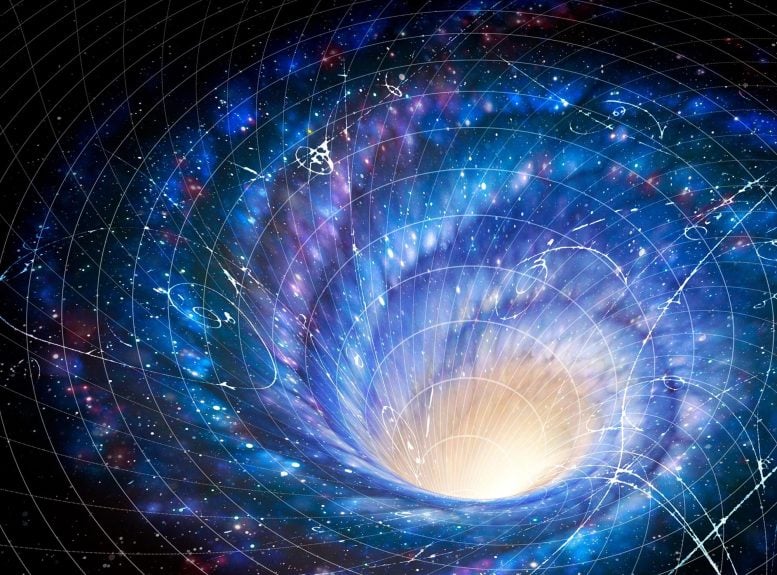
A recent study reveals that the orbital motions of widely separated binary stars, or “wide binaries,” break down the standard model of gravity at low accelerations. Analyzing data from 26,500 wide binaries, researchers found that accelerations below one nanometer per second squared deviate from Newton’s and Einstein’s gravitational laws.
A study on the orbital motions of wide binaries has uncovered evidence that standard gravity breaks down at low accelerations. This discovery aligns with a modified theory called MOND and challenges current concepts of dark matter. The implications for astrophysics, physics, and cosmology are profound, and the results have been acknowledged as a significant discovery by experts in the field.
A new study reports conclusive evidence for the breakdown of standard gravity in the low acceleration limit, stemming from a verifiable analysis of the orbital motions of long-period, widely separated binary stars. These stars are commonly referred to as wide binaries in astronomy and astrophysics. The study was carried out by Kyu-Hyun Chae, professor of physics and astronomy at Sejong University in Seoul, and it used up to 26,500 wide binaries within 650 light years (LY), observed by the European Space Agency’s Gaia space telescope.
Methodology
For a significant improvement over other research, Chae’s study concentrated on calculating the gravitational accelerations experienced by binary stars as a function of their separation or equivalently, the orbital period. This was achieved by a Monte Carlo deprojection of observed sky-projected motions to three-dimensional space.
Chae explains, “From the start, it seemed clear to me that gravity could be most directly and efficiently tested by calculating accelerations because the gravitational field itself is an acceleration. My recent research experiences with galactic rotation curves led me to this idea. Galactic disks and wide binaries share some similarity in their orbits, though wide binaries follow highly elongated orbits while hydrogen gas particles in a galactic disk follow nearly circular orbits.”
In addition, Chae calibrated the occurrence rate of hidden nested inner binaries at a benchmark acceleration, unlike other studies.
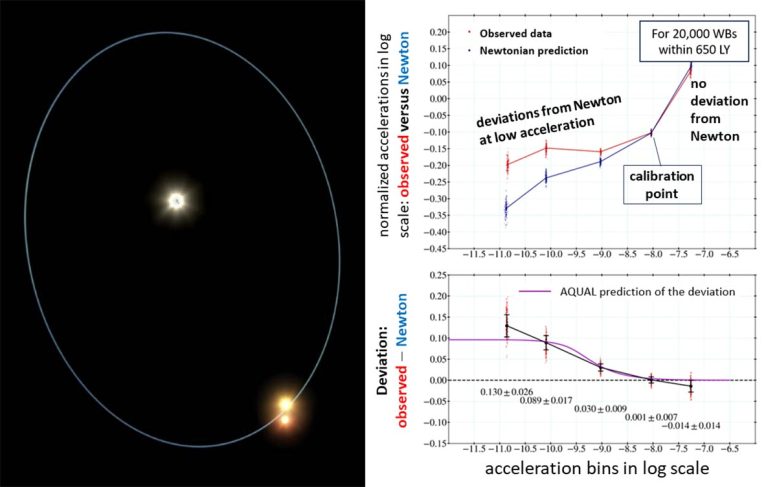
Left: A binary star system with a nested inner binary (credit: Wikipedia). Right: Gravitational anomaly at low acceleration observed in 20,000 wide binaries Credit: Kyu-Hyun Chae
Findings
The study reveals that when two stars orbit each other with accelerations lower than about one nanometer per second squared, they start to deviate from predictions by Newton’s universal law of gravitation and Einstein’s general relativity. For accelerations lower than approximately 0.1 nanometer per second squared, the observed acceleration is about 30 to 40 percent higher than the Newton-Einstein prediction. The significance is considerable, meeting the conventional criteria of 5 sigma for a scientific discovery. In a sample of 20,000 wide binaries within a distance limit of 650 LY, two independent acceleration bins respectively show deviations of over 5 sigma significance in the same direction.
Because the observed accelerations stronger than about 10 nanometers per second squared agree well with the Newton-Einstein prediction from the same analysis, the observed boost of accelerations at lower accelerations is a mystery. Intriguingly, this breakdown of the Newton-Einstein theory at weaker accelerations was suggested 40 years ago by theoretical physicist Mordehai Milgrom at the Weizmann Institute in Israel in a new theoretical framework called modified Newtonian dynamics (MOND) or Milgromian dynamics in current usage.
Connection to MOND
The boost factor of about 1.4 is correctly predicted by a MOND-type Lagrangian theory of gravity called AQUAL, proposed by Milgrom and the late physicist Jacob Bekenstein. What’s remarkable is that the correct boost factor requires the external field effect from the Milky Way galaxy, a unique prediction of MOND-type modified gravity. Thus, the wide binary data indicate not only the breakdown of Newtonian dynamics but also the manifestation of the external field effect of modified gravity.
Chae’s Insight
On the results, Chae says, “It seems impossible that a conspiracy or unknown systematic can cause these acceleration-dependent breakdowns of the standard gravity in agreement with AQUAL. I have examined all possible systematics as described in the rather long paper. The results are genuine. I foresee that the results will be confirmed and refined with better and larger data in the future. I have also released all my codes for the sake of transparency and to serve any interested researchers.”
Implications and Limitations
Unlike galactic rotation curves, where the observed boosted accelerations can theoretically be attributed to dark matter in the Newton-Einstein standard gravity, wide binary dynamics cannot be affected by it even if it existed. The standard gravity simply breaks down in the weak acceleration limit in accordance with the MOND framework.
The implications of wide binary dynamics are profound for astrophysics, theoretical physics, and cosmology. Anomalies in Mercury’s orbits observed in the nineteenth century eventually led to Einstein’s general relativity. Now anomalies in wide binaries demand a new theory extending general relativity to the low acceleration MOND limit.
Despite all the successes of Newton’s gravity, general relativity is needed for relativistic gravitational phenomena such as black holes and gravitational waves. Likewise, despite all the successes of general relativity, a new theory is needed for MOND phenomena in the weak acceleration limit. The weak-acceleration catastrophe of gravity may have some similarity to the ultraviolet catastrophe of classical electrodynamics that led to quantum physics.
Revolution in Physics
Wide binary anomalies are disastrous for standard gravity and cosmology that rely on dark matter and dark energy concepts. Since gravity follows MOND, a large amount of dark matter in galaxies (and even in the universe) is no longer needed. This is a significant surprise to Chae who, like typical scientists, “believed in” dark matter until a few years ago.
A new revolution in physics seems now underway. On the present results and the future prospects, Milgrom says, “Chae’s finding is a result of a very involved analysis of cutting-edge data, which, as far as I can judge, he has performed very meticulously and carefully. But for such a far-reaching finding — and it is indeed very far-reaching — we require confirmation by independent analyses, preferably with better future data. If this anomaly is confirmed as a breakdown of Newtonian dynamics, and especially if it indeed agrees with the most straightforward predictions of MOND, it will have enormous implications for astrophysics, cosmology, and for fundamental physics at large.”
Peer Opinions
Xavier Hernandez, professor at UNAM in Mexico who first suggested wide binary tests of gravity a decade ago, says, “It is exciting that the departure from Newtonian gravity that my group has claimed for some time has now been independently confirmed, and impressive that this departure has for the first time been correctly identified as accurately corresponding to a detailed MOND model. The unprecedented accuracy of the Gaia satellite, the large and meticulously selected sample Chae uses and his detailed analysis, make his results sufficiently robust to qualify as a discovery.”
Pavel Kroupa, professor at Bonn University and at Charles University in Prague, has come to the same conclusions concerning the law of gravitation. He says, “With this test on wide binaries as well as our tests on open star clusters nearby the Sun, the data now compellingly imply that gravitation is Milgromian rather than Newtonian. The implications for all of astrophysics are immense.”
The finding was published in the 1 August 2023 issue of The Astrophysical Journal.
Reference: “Breakdown of the Newton–Einstein Standard Gravity at Low Acceleration in Internal Dynamics of Wide Binary Stars” by Kyu-Hyun Chae, 24 July 2023, The Astrophysical Journal.
DOI: 10.3847/1538-4357/ace101

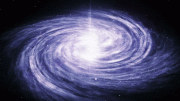
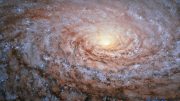
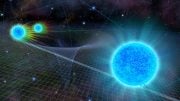
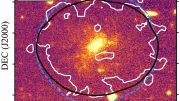


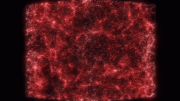
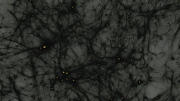
Some people are treating the anomalous acceleration like it’s a step function. I doubt that is appropriate, but the anomaly does apparently dependent on distance. I have to suppose here the magnitude of the supposed anomalous step necessarily tests the resolving power of the instrumentation, to obtain quickest results. Seems clearly much more realistic to suppose a low-order nonlinearity in acceleration is involved instead of any alleged step discontinuities.
Comparing a factor of 1.4 to (100% +) 30%-40% is not impressing me at the moment, I am often running into factors involving the square root of two (1.414…) when thinking about gravity flows under a dimensional reduction in retro-reflective focus.
“anomaly does apparently depend on distance”
Looks like they’re “wide” and also necessarily narrow at times, so the period is practical for a quick study. The narrow phase would be the critical part for frame-dragging effects, which would affect the entire orbit, including the wide phase.
Now that wide/narrow comment is probably the only sensible thing you have ever posted. Kudos.
Idiot.
Now, do you see why you are always wrong? Your being “impressed” by some numbers doesn’t matter to the universe. The universe isn’t here to impress some narcissistic Dunning-Krüger poster boy.
Idiot.
I first uploaded a video of locally generated gravity being intensified in rotating wheels to my YouTube video channel in 2012, since deleted by me after being censored by YouTube about the Covid-19 ‘scamdemic.’ It’s now uploaded (with two newer ones) to my still non-monetary Odysee dot com/@charlesgshaver video channel. I postulate that a still unidentified force, perhaps reverberations of the Big Bang, induce gravity in all objects and rotation of an object simply exposes more matter per unit of time to the constant influence of that mysterious force. With some possible disagreement on the accuracy of distance measurements, the article appears to support my lay findings.
Getting kicked off a platform where even utter morons can thrive should have been an eye-opener for you. Don’t quit your day job… Unless it’s for another J6 “tourist walkthrough”.
“Cosmic Mystery: A Massive Galaxy Defying Dark Matter Theories”
Go save MOND here, like the self-centered worthless idiot you are.
I know, you were too wasted to notice it before.
“Unless it’s for another J6 ‘tourist walkthrough’.”
LOL, now that’s some funny political humor, idiot. Sure you don’t work dark MAGA for Rump?
What, theHeck? I quit YouTube for their censorship of accurate honest information about the phony Covid-19 pandemic and the actual underlying causes of so much cheaply and easily prevented chronic disease and premature mortality in the US, as part of my unpaid altruist retiree day job. Similarly, with the FDA all but ending my musical aspirations with their unlawful approval of the expanded use of added ‘cultured-free’ MSG in 1980, I share my particular personal ‘insights’ into gravity with any scientifically objective parties I might encounter along the way. What’s your gig?
If the peer review proves confident in the modified gravity data and in conjunction with Newton Einstein standard, add a little imagination of manipulation our quest for using these processes to free the bond of gravity will present its achievement. visual of large systems then converting to atomic levels have the potential in the standard level.
Don’t believe everything you read on the web.
Oh, absolutely, “Conclusive”. No comments about the gravitational lensing from the non-existent dark matter?
Even if this observation is “true” within the error bars of the measurement this MOND hypothesis cannot explain the all the other predictions and observations with respect to General Relativity. To contrast the .1 nanometer per second squared “Low Acceleration” of binary stars system with the Earth acceleration toward the Sun which is approximately 60,000,000 nanometer per second squared. Could the measurement uncertainty account for the difference?
The gravitational pull remains a mystery as to the forces that forms the core of this Earth. It can’t be iron and nickel since they can’t confront 5000* C and remain iron & nickel.
That makes absolutely no sense at all.
Maybe it’s going to be a permanent gimmick for MOND fanatics (evolved Einsteinian con-artists) to never make any comparisons to “frame dragging,” even if just to mention it in passing, in their sensationalist articles. It is a level of incompetence befitting an Einsteinian false opposition mold though. Maybe frame drag could seem too quantum and fundamental for even passing mention in an article that praises MOND.
It should also be noted that astrophysicists cannot place/locate dark matter in a galaxy that produces the observed rotations velocities.
When Dark Energy, Dark Matter, and ordinary matter are added together, they come to 100%. This is not by empirical data, but by inferring the contributions of what Dark Matter and Dark Energy need for the total to be 100%.
Dark matter might exist, but all attempts to identify it have failed. Add in the above detail, and a better way to describe ‘Dark Matter’ is that it is a placeholder for an unexplained phenomenon. Heck, even Dark Energy doesn’t fit with General Relativity or our present understanding of particle physics.
(Consider the Lithium balance problem with the Big Bang/Inflationary model. Or that even one of the originators of Inflation says it does not predict current observations. We should consider much of astrophysics to be a best guess. These ideas, i.e. Dark Matter and Dark Energy, are not consistent with other well-established frameworks, and are thus speculative.)